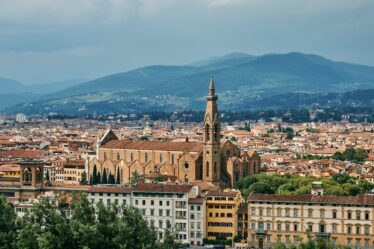

When Napoleon turned the Arno into French territory
Storm over Florence — this is the story of how, in 1808, Florence became French overnight. No parades, no toasts—just a new flag and a lot more paperwork, in French of course. One day the city was part of Tuscany, the next, it was the “Département de l’Arno.” Same Duomo, different empire. What followed was nearly a decade of rule that felt more like an operetta than an occupation—colorful, ironic, and, ultimately, fleeting.
From Tuscany to the Département de l’Arno
In 1808, Napoleon’s grip on Europe was at its peak. As part of his grand reorganization of the Italian Peninsula, Florence was annexed into the French Empire and transformed into the Département de l’Arno. Suddenly, Italian became secondary, and Storm over Florence had truly begun.
The new rulers arrived with their signature flair: uniforms, legal codes, and an unshakable belief that they were “civilizing” the locals. These so-called reforms included the Napoleonic Code, centralized administration, and the enforcement of French as the official language. Florence, however, wasn’t entirely convinced it needed to be civilized.
To learn more about the Napoleonic Code and its impact across Europe, see Britannica’s article on Napoleonic Code.
Florentine Irony: Enter the “Nuvoloni”
Yet, despite the seriousness of the French occupation, Florentines never lost their biting sense of humor. When French officials kept shouting “Nous voulons!” (We want!), the locals slyly dubbed them “nuvoloni”—literally, big clouds. It was a perfect pun. These foreigners loomed large, blocked the sun, and brought a storm of decrees and military presence.
Thus, the phrase Storm over Florence found new meaning in the daily life of the citizens, who felt increasingly under a metaphorical weather system of French rule.
For context about life in Florence under French occupation, visit Museo Galileo’s historical archives.
A Decade of Shadows
For nearly ten years, Florence lived under the shadow of Napoleon. Streets were renamed, institutions reshaped, and taxes increased. But amidst the bureaucracy, the Tuscan identity held firm. The Florentines learned to nod politely while keeping their own customs alive behind the scenes.
Meanwhile, Storm over Florence was not just about governance—it was also about identity, resilience, and subtle rebellion.
Explore how Napoleon reshaped Italy during this era on Napoleon.org’s Italian Campaigns page.
The Clouds Clear: 1814 and the Return of the Habsburg-Lorraine
In 1814, Napoleon was forced into exile, and with his fall came the end of the French era in Florence. The “nuvoloni” drifted away, and the Austrian Habsburg-Lorraine dynasty resumed control. They were less theatrical, perhaps, but still foreign rulers.
Even so, Florence never truly surrendered its soul. Despite the clouds of foreign rule, it remained intellectually and culturally independent. Storm over Florence may have ended on the surface, but the memory lingered in Florentine humor, language, and pride.
For further reading on the return of the Habsburg-Lorraine and the Congress of Vienna, check History.com’s summary of 1814 events.
Conclusion: A Storm That Passed, but Not Forgotten
Storm over Florence reminds us that even during periods of foreign domination, the identity of a city—especially one as proud as Florence—can survive through irony, culture, and quiet resistance. The French may have tried to impose their order, but the Florentines had their own way of weathering the storm.



